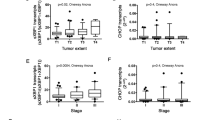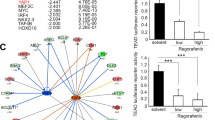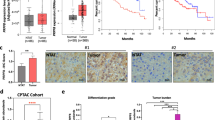Abstract
Epithelial splicing regulatory protein 1 (ESRP1) binds the FGFR-2 auxiliary cis-element ISE/ISS-3, located in the intron between exon IIIb and IIIc, and primarily promotes FGFR-2 IIIb expression. Here we assessed the role of ESRP1 in pancreatic ductal adenocarcinoma (PDAC). Immunohistochemical analysis was performed using anti-ESRP1, FGFR-2 IIIb and FGFR-2 IIIc antibodies in 123 PDAC cases. ESRP1 expression vector and small interference RNA (siRNA) targeting ESRP1 were transfected into human PDAC cells, and cell growth, migration and invasion were analyzed. In vivo heterotopic and orthotopic implantations using ESRP1 overexpression clones were performed and effects on pancreatic tumor volumes and hepatic and pulmonary metastases determined. ESRP1 immunoreactivity was strong in the nuclei of cancer cells in well-to-moderately differentiated PDACs but weak in poorly differentiated cancers. Well-to-moderately differentiated cancers also exhibited high FGFR-2 IIIb and low FGFR-2 IIIc expression, whereas this ratio was reversed in the poorly differentiated cancers. Increased ESRP1 expression was associated with longer survival in comparison with low ESRP1 expression, and PANC-1 cells engineered to express ESRP1 exhibited increased FGFR-2 IIIb expression and decreased migration and invasion in vitro, whereas ESRP1 siRNA-transfected KLM-1 cells exhibited increased FGFR-2 IIIc expression and increased cell growth, migration and invasion. In vivo, ESRP1-overexpressing clones formed significantly fewer liver metastases as compared with control clones. ESRP1 regulates the expression pattern of FGFR-2 isoforms, attenuates cell growth, migration, invasion and metastasis, and is a favorable prognostic factor in PDAC. Therefore, devising mechanisms to upregulate ESRP1 may exert a beneficial therapeutic effect in PDAC.
This is a preview of subscription content, access via your institution
Access options
Subscribe to this journal
Receive 50 print issues and online access
$259.00 per year
only $5.18 per issue
Buy this article
- Purchase on Springer Link
- Instant access to full article PDF
Prices may be subject to local taxes which are calculated during checkout






Similar content being viewed by others
References
Siegel R, Naishadham D, Jemal A . Cancer statistics, 2012. CA Cancer J Clin 2012; 62: 10–29.
Cho K, Ishiwata T, Uchida E, Nakazawa N, Korc M, Naito Z et al. Enhanced expression of keratinocyte growth factor and its receptor correlates with venous invasion in pancreatic cancer. Am J Pathol 2007; 170: 1964–1974.
Ishiwata T, Friess H, Buchler MW, Lopez ME, Korc M . Characterization of keratinocyte growth factor and receptor expression in human pancreatic cancer. Am J Pathol 1998; 153: 213–222.
Dionne CA, Crumley G, Bellot F, Kaplow JM, Searfoss G, Ruta M et al. Cloning and expression of two distinct high-affinity receptors cross-reacting with acidic and basic fibroblast growth factors. EMBO J 1990; 9: 2685–2692.
Miki T, Fleming TP, Bottaro DP, Rubin JS, Ron D, Aaronson SA . Expression cDNA cloning of the KGF receptor by creation of a transforming autocrine loop. Science 1991; 251: 72–75.
Savagner P, Valles AM, Jouanneau J, Yamada KM, Thiery JP . Alternative splicing in fibroblast growth factor receptor 2 is associated with induced epithelial-mesenchymal transition in rat bladder carcinoma cells. Mol Biol Cell 1994; 5: 851–862.
Katoh M . FGFR2 abnormalities underlie a spectrum of bone, skin, and cancer pathologies. J Invest Dermatol 2009; 129: 1861–1867.
Baum B, Settleman J, Quinlan MP . Transitions between epithelial and mesenchymal states in development and disease. Semin Cell Dev Biol 2008; 19: 294–308.
Yan G, Fukabori Y, McBride G, Nikolaropolous S, McKeehan WL . Exon switching and activation of stromal and embryonic fibroblast growth factor (FGF)-FGF receptor genes in prostate epithelial cells accompany stromal independence and malignancy. Mol Cell Biol 1993; 13: 4513–4522.
Ishiwata T, Matsuda Y, Yamamoto T, Uchida E, Korc M, Naito Z . Enhanced expression of fibroblast growth factor receptor 2 IIIc promotes human pancreatic cancer cell proliferation. Am J Pathol 2012; 180: 1928–1941.
Hovhannisyan RH, Carstens RP . Heterogeneous ribonucleoprotein m is a splicing regulatory protein that can enhance or silence splicing of alternatively spliced exons. J Biol Chem 2007; 282: 36265–36274.
Mauger DM, Lin C, Garcia-Blanco MA . hnRNP H.and hnRNP F complex with Fox2 to silence fibroblast growth factor receptor 2 exon IIIc. Mol Cell Biol 2008; 28: 5403–5419.
Warzecha CC, Sato TK, Nabet B, Hogenesch JB, Carstens RP . ESRP1 and ESRP2 are epithelial cell-type-specific regulators of FGFR2 splicing. Mol Cell 2009; 33: 591–601.
Warzecha CC, Shen S, Xing Y, Carstens RP . The epithelial splicing factors ESRP1 and ESRP2 positively and negatively regulate diverse types of alternative splicing events. RNA Biol 2009; 6: 546–562.
Leontieva OV, Ionov Y . RNA-binding motif protein 35A is a novel tumor suppressor for colorectal cancer. Cell Cycle 2009; 8: 490–497.
Gemmill RM, Roche J, Potiron VA, Nasarre P, Mitas M, Coldren CD et al. ZEB1-responsive genes in non-small cell lung cancer. Cancer Lett 2011; 300: 66–78.
Onder TT, Gupta PB, Mani SA, Yang J, Lander ES, Weinberg RA . Loss of E-cadherin promotes metastasis via multiple downstream transcriptional pathways. Cancer Res 2008; 68: 3645–3654.
Shapiro IM, Cheng AW, Flytzanis NC, Balsamo M, Condeelis JS, Oktay MH et al. An EMT-driven alternative splicing program occurs in human breast cancer and modulates cellular phenotype. PLoS Genet 2011; 7: e1002218.
Warzecha CC, Jiang P, Amirikian K, Dittmar KA, Lu H, Shen S et al. An ESRP-regulated splicing programme is abrogated during the epithelial-mesenchymal transition. EMBO J 2010; 29: 3286–3300.
Thiery JP, Sleeman JP . Complex networks orchestrate epithelial-mesenchymal transitions. Nat Rev Mol Cell Biol 2006; 7: 131–142.
Hruban RH, Maitra A, Goggins M . Update on pancreatic intraepithelial neoplasia. Int J Clin Exp Pathol 2008; 1: 306–316.
Hezel AF, Kimmelman AC, Stanger BZ, Bardeesy N, Depinho RA . Genetics and biology of pancreatic ductal adenocarcinoma. Genes Dev 2006; 20: 1218–1249.
Esposito I, Menicagli M, Funel N, Bergmann F, Boggi U, Mosca F et al. Inflammatory cells contribute to the generation of an angiogenic phenotype in pancreatic ductal adenocarcinoma. J Clin Pathol 2004; 57: 630–636.
Korc M . Role of growth factors in pancreatic cancer. Surg Oncol Clin N Am 1998; 7: 25–41.
Jones S, Zhang X, Parsons DW, Lin JC, Leary RJ, Angenendt P et al. Core signaling pathways in human pancreatic cancers revealed by global genomic analyses. Science 2008; 321: 1801–1806.
Hidalgo M . Pancreatic cancer. N Engl J Med 2010; 362: 1605–1617.
Korc M, Friesel RE . The role of fibroblast growth factors in tumor growth. Curr Cancer Drug Targets 2009; 9: 639–651.
Feig C, Gopinathan A, Neesse A, Chan DS, Cook N, Tuveson DA . The pancreas cancer microenvironment. Clin Cancer Res 2012; 18: 4266–4276.
Joyce JA, Pollard JW . Microenvironmental regulation of metastasis. Nat Rev Cancer 2009; 9: 239–252.
Grivennikov SI, Greten FR, Karin M . Immunity, inflammation, and cancer. Cell 2010; 140: 883–899.
Nguyen DX, Bos PD, Massague J . Metastasis: from dissemination to organ-specific colonization. Nat Rev Cancer 2009; 9: 274–284.
Di Modugno F, Iapicca P, Boudreau A, Mottolese M, Terrenato I, Perracchio L et al. Splicing program of human MENA produces a previously undescribed isoform associated with invasive, mesenchymal-like breast tumors. Proc Natl Acad Sci USA 2012; 109: 19280–19285.
Pan Q, Shai O, Lee LJ, Frey BJ, Blencowe BJ . Deep surveying of alternative splicing complexity in the human transcriptome by high-throughput sequencing. Nat Genet 2008; 40: 1413–1415.
Wang ET, Sandberg R, Luo S, Khrebtukova I, Zhang L, Mayr C et al. Alternative isoform regulation in human tissue transcriptomes. Nature 2008; 456: 470–476.
Johnson M, Sharma M, Henderson BR . IQGAP1 regulation and roles in cancer. Cell Signal 2009; 21: 1471–1478.
Wickstrom SA, Lange A, Hess MW, Polleux J, Spatz JP, Kruger M et al. Integrin-linked kinase controls microtubule dynamics required for plasma membrane targeting of caveolae. Dev Cell 2010; 19: 574–588.
Bailey KM, Liu J . Caveolin-1 up-regulation during epithelial to mesenchymal transition is mediated by focal adhesion kinase. J Biol Chem 2008; 283: 13714–13724.
Yan L, Gu H, Li J, Xu M, Liu T, Shen Y et al. RKIP and 14–3-3epsilon exert an opposite effect on human gastric cancer cells SGC7901 by regulating the ERK/MAPK pathway differently. Dig Dis Sci 2013; 58: 389–396.
Brown RL, Reinke LM, Damerow MS, Perez D, Chodosh LA, Yang J et al. CD44 splice isoform switching in human and mouse epithelium is essential for epithelial-mesenchymal transition and breast cancer progression. J Clin Invest 2011; 121: 1064–1074.
Rhim AD, Mirek ET, Aiello NM, Maitra A, Bailey JM, McAllister F et al. EMT and dissemination precede pancreatic tumor formation. Cell 2012; 148: 349–361.
Tuveson DA, Neoptolemos JP . Understanding metastasis in pancreatic cancer: a call for new clinical approaches. Cell 2012; 148: 21–23.
Kawase R, Ishiwata T, Matsuda Y, Onda M, Kudo M, Takeshita T et al. Expression of fibroblast growth factor receptor 2 IIIc in human uterine cervical intraepithelial neoplasia and cervical cancer. Int J Oncol 2010; 36: 331–340.
Matsuda Y, Yamamoto T, Kudo M, Kawahara K, Kawamoto M, Nakajima Y et al. Expression and roles of lumican in lung adenocarcinoma and squamous cell carcinoma. Int J Oncol 2008; 33: 1177–1185.
Matsuda Y, Naito Z, Kawahara K, Nakazawa N, Korc M, Ishiwata T . Nestin is a novel target for suppressing pancreatic cancer cell migration, invasion and metastasis. Cancer Biol Ther 2011; 11: 512–523.
Gorg A, Obermaier C, Boguth G, Csordas A, Diaz JJ, Madjar JJ . Very alkaline immobilized pH gradients for two-dimensional electrophoresis of ribosomal and nuclear proteins. Electrophoresis 1997; 18: 328–337.
Gorg A, Obermaier C, Boguth G, Weiss W . Recent developments in two-dimensional gel electrophoresis with immobilized pH gradients: wide pH gradients up to pH 12, longer separation distances and simplified procedures. Electrophoresis 1999; 20: 712–717.
Suemizu H, Monnai M, Ohnishi Y, Ito M, Tamaoki N, Nakamura M . Identification of a key molecular regulator of liver metastasis in human pancreatic carcinoma using a novel quantitative model of metastasis in NOD/SCID/gammacnull (NOG) mice. Int J Onco 2007; 31: 741–751.
Seiden-Long I, Navab R, Shih W, Li M, Chow J, Zhu CQ et al. Gab1 but not Grb2 mediates tumor progression in Met overexpressing colorectal cancer cells. Carcinogenesis 2008; 29: 647–655.
Acknowledgements
We express our appreciation to Dr Masahito Hagio for helpful discussion and Dr Tetsushi Yamamoto, Mr Yuji Yanagisawa, Ms Taeko Suzuki, Ms Yoko Kawamoto and Ms Kiyoko Kawahara (Department of Pathology, Nippon Medical School) for their excellent technical assistance. We also thank Dr Shin-ichi Tsuchiya (Division of Surgical Pathology, Nippon Medical School Hospital) for preparing tissue blocks. This work was supported by Grants-in-Aid for Scientific Research (C, No.22591531 for TI), a Grant-in-Aid for Young Scientists (A, No. 22689038 for YM) a Grant-in-Aid for Challenging Exploratory Research (No. 23650604 for YM) from the Japan Society for the Promotion of Science, and in part by NIH grant R37-CA-075059 to MK.
Author information
Authors and Affiliations
Corresponding author
Ethics declarations
Competing interests
The authors declare no conflict of interest.
Additional information
Supplementary Information accompanies this paper on the Oncogene website
Supplementary information
Rights and permissions
About this article
Cite this article
Ueda, J., Matsuda, Y., Yamahatsu, K. et al. Epithelial splicing regulatory protein 1 is a favorable prognostic factor in pancreatic cancer that attenuates pancreatic metastases. Oncogene 33, 4485–4495 (2014). https://doi.org/10.1038/onc.2013.392
Received:
Revised:
Accepted:
Published:
Issue Date:
DOI: https://doi.org/10.1038/onc.2013.392
Keywords
This article is cited by
-
Splicing alterations in pancreatic ductal adenocarcinoma: a new molecular landscape with translational potential
Journal of Experimental & Clinical Cancer Research (2023)
-
Role of epithelial splicing regulatory protein 1 in cancer progression
Cancer Cell International (2023)
-
RBFOX2 deregulation promotes pancreatic cancer progression and metastasis through alternative splicing
Nature Communications (2023)
-
ESRP1-regulated isoform switching of LRRFIP2 determines metastasis of gastric cancer
Nature Communications (2022)
-
Underlying mechanisms of epithelial splicing regulatory proteins in cancer progression
Journal of Molecular Medicine (2022)



